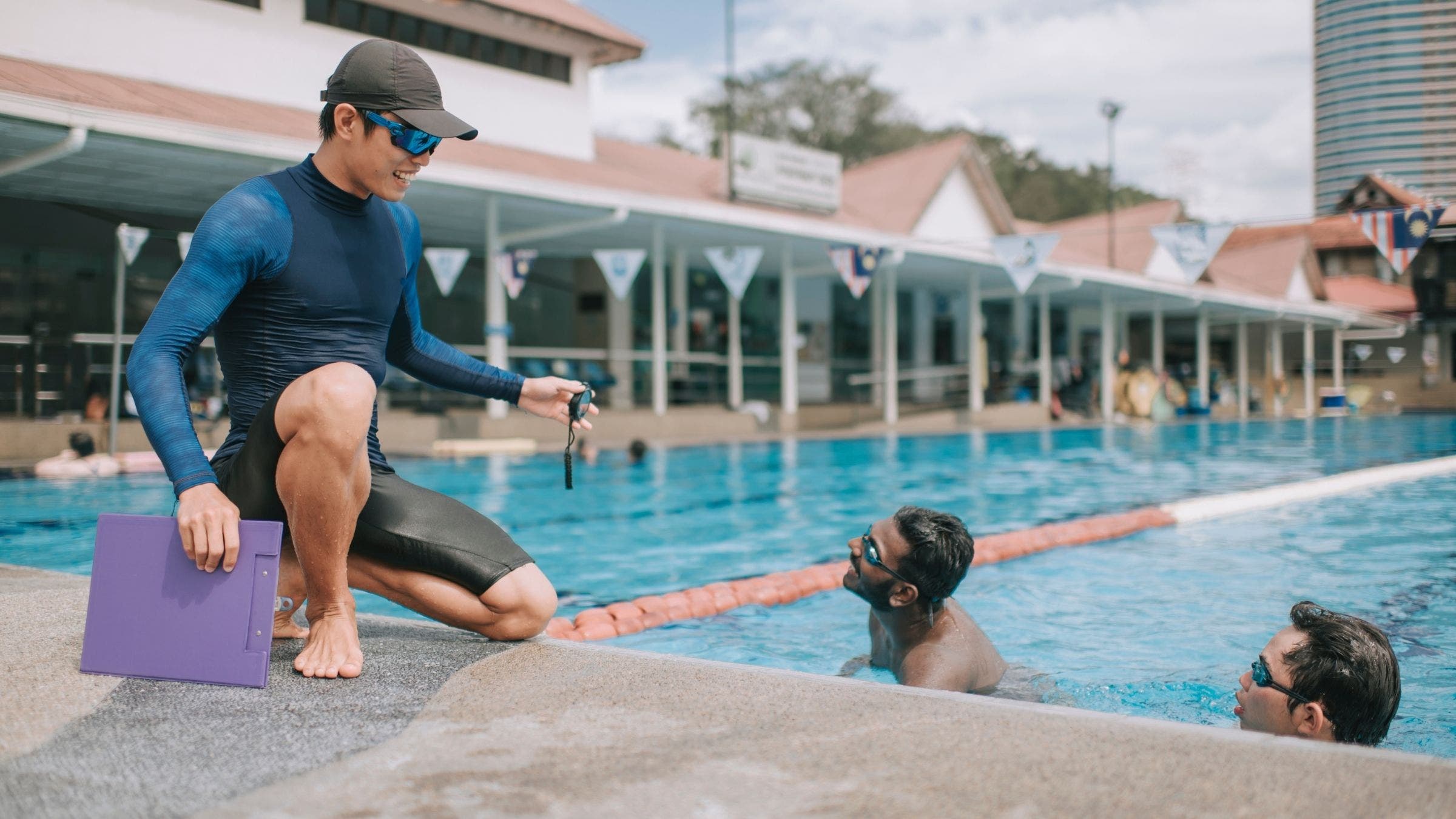Pull Back the Curtain on the "Why" Behind Your Workouts

(Photo: Getty Images)
Table of Contents
10×100, the long ride, the tempo run, mile repeats. As triathletes, we’ve either done or seen most of these workouts–but how many of us can explain why we do them? When you strap on your bike helmet to do that threshold set, you know what you’re going to do, but do you know what the point and purpose is? Well, you should. Blindly following a training plan might just be keeping you from reaching the next level of fitness.
“Every workout has a purpose,” explained Caleb Guest, USAT Level 2 coach at Triplex Training. “The better an athlete understands the reason behind each workout, the better they are able to accomplish their training sessions appropriately.”
Why the “why” is crucial
Most triathletes think of coaches as people who know the secret formula to triathlon success—do this many swim workouts, bike for this long, and boom, you’re a triathlete. But in reality, good triathlon coaches are educators. Their aim is not only to help you achieve your triathlon goals, but to teach you how to be a better triathlete. Following a training plan—and, more importantly, asking questions about it—is your way of learning the secret formula to triathlon success.
“When triathletes understand why they are performing a particular workout, they are more likely to comply with the workout’s targets, execute the session appropriately, and effectively communicate feedback on how the session went,” said Guest. “This, in turn, helps determine how the overall program is going and where it should go moving forward.”
Understanding the motives behind your workout can also help you to challenge what you think you know about triathlon training. Many of us hold inaccurate assumptions about how to train, which can keep us from reaching our potential. Notions like the 10% rule, which states you should only increase your mileage or intensity by 10% each week, have largely been debunked by researchers like Dr. Tim Gabbett, an applied sport scientist, yet many of us still hold them as gospel.
“Our beliefs are developed from what we’ve read and what we’ve heard, and they’re really ingrained,” Gabbett said. If you believe that training hard is a bad thing, or that you shouldn’t go over a certain number of miles per week, you might hold yourself back during workouts, no matter what your plan says. The same can be true of the opposite—some people believe the only way to get better is to train hard all the time, so they ignore instructions to go easy on easy days. Knowing the why behind your workout can be a key part of changing those beliefs and feeling confident about carrying out each session the way it’s written.
“It’s important to trust the plan and the process, but blind faith usually results in missed opportunities for improvement,” Guest said. “As athletes we need to listen to our bodies, seek to find balance between our lives and our sport, and own being a part of our training plan.”
Here’s how to identify the reasoning behind each workout.

Why am I doing this workout today?
Training capacity
Knowing the why behind the workout can help dial in the appropriate amount of intensity to stave off overtraining and burnout. Training load is a key element of triathlon training. Each session should be designed to hit exactly the appropriate amount of stimulus based on what is happening to your body in and out of training. Gabbett uses a specific analogy to help athletes understand why each workout is designed the way it is:
“Think of your capacity as being like a cup,” Gabbett said. “You can only fill it up to a certain amount. You can fill that up with training load, sure, but it also fills up with a whole heap of other things you have to do as part of your life. It could be emotional stress, it could be lifestyle, it could be a lack of sleep—those fill up the cup, too. You could have the ideal training program on paper, but all you need is a change in sleep patterns, or hydration or nutrition, or emotional stress. And then that training program starts to look a little different, because your capacity shrinks. Not because you’ve lost strength, or aerobic fitness, or speed, but simply because you’ve had a transient reduction in health that impacts your load capacity.”
Periodization
When executing periodization properly certain workouts are performed at a certain time in the training cycle in order to get the best results, Guest said. “Workouts are placed in a particular order inside a microcycle, like a weekly schedule, to make sure they can be executed properly and again to provoke certain adaptations.”
For example, technique-based workouts need to be performed when the athlete is fresh, in order to make sure they are executing the drills properly. Other sessions need to be spaced apart in order to ensure the athlete gets the recovery time necessary for their body to adapt to the training load previously placed on it. Strength sessions, for example, are followed by recovery workouts, which then allow athletes to move on to quality high-intensity sessions without risk of injury or burnout.
Preparation
One of the most common mistakes athletes make is doing more than their bodies can handle. This is particularly true in cases where the athlete is coming back from a prolonged period of rest—say, an offseason break or while recovering from an injury. That’s why training-related injuries are more likely to happen in the spring, as athletes try to pick up where they left off in the fall. The body needs time to adapt to that load, and a well-designed training plan takes into account what has (or hasn’t) happened in the weeks and months prior.
“If you’ve started at a very low base, and you go from the basement up to the ceiling really quickly, you’re going to run the risk of getting these overuse injuries—or, as I like to call them, under-preparation injuries,” Gabbett said. “It’s not actually high training loads that are the problem, it’s more likely that it’s the way you’ve gotten to those training loads. You want to build progressively and gradually to those higher training loads, so that you’ll have robustness and resilience against these injuries.”
Your strengths and weaknesses
It’s likely you’ve got a preference for one discipline over another, and it shows in the way you train. Triathletes have a tendency to favor the training they’re best at, so they may scrunch their nose at a planned swim workout and decide to go for a bike ride instead, or swap out a drill-heavy session for an easy ride. But there’s a reason those workouts exist, and that reason is to train your weaknesses. Sure, you might not love threshold sessions on the bike, but if you do them, you’ll become a better cyclist. This, in turn, will set you up to enjoy the run leg of your race even more than you already do.
How to modify workouts (the right way)
If you’re going to make changes to your training plan, Guest advises athletes to use the “why” behind the workout as the guiding principle. If the athlete is not sure why they’re performing a particular workout, then they are likely to do the easy sessions too hard and either skip, modify, or perform the technique sessions in a fatigued state, which can lead to poor form and injury.
“If an athlete is aware of the phase of training they are undergoing and they understand the impact each workout has towards their fitness goals they will be better able to make on the fly adjustments when life happens,” Guest said. “Each session has a purpose, interacts with the sessions around it and has a priority based on the phase of training, the athletes strengths and weakness and their personal goals. By understanding this priority, an athlete is able to know when they should just skip a workout, move a workout, or modify a workout.”
For example, if an athlete is only concerned about getting in the scheduled duration of a workout, they might overlook critical factors like intensity, timing, or the reason behind an interval schedule. If they flip Tuesday’s 60-minute interval session with Friday’s 60-minute easy run, they might not realize too late that it’s been stacked on top of Thursday’s hard bike workout. “The athlete ends up going into this workout tired from the week and hard bike. They’ll find themselves just running to get in the time, without any emphasis on the intervals or assigned intensity,” Guest said. “A workout originally designed to help them develop speed is now, at best, a fatigue resistance workout and at worst just causing excess fatigue and overtraining.”
Balancing swimming, running, biking and strength workouts is challenging and just about every athlete will experience, at times, a disruption to their training schedule. The better an athlete is in tune with their goals, understands the periodization schedule and the purpose behind each workout, the better off they are at being able to adjust for these disruptions.

The Workout Cheat Sheet
Explaining some of the most common workouts you’ll see on a training plan.
10×100 time trial swim
The workout:
Warm-up:
200 easy swim, :20 rest
4 x 50 kick, :15 rest
4 x 50 pull, :15 rest
200 moderate swim, :20 rest
Main Set:
10 x 100 time trial, :10 rest
Try to aim for the same time for each 100. Aim to keep the recovery to only 10 seconds between each one.
Cool-down:
100 easy choice of drill, :30 rest
100 easy choice of stroke
The why:
According to coach Alison Kreideweis, many triathletes don’t know their race or steady swim pace. “Often times, when I ask a triathlete what their ‘swim pace is’ they have no idea,” Kreideweis said. “Additionally, I often get questions from athletes about how long I think it will take them to complete their triathlon swim, which is impossible to answer without knowing how fast they can swim.”
The 10×100 time trial set, a staple of triathlon swimming, is a great test set to help athletes determine their swim pace (often described in “pace per 100”) and estimate their finishing time for a race. When performed on a consistent basis (say, the first swim of every month), this set can help triathletes note whether progress is being made or if training needs to be tweaked.
Threshold Power Ride
The workout:
Warm-up:
10 minutes in heart-rate zone 1 to 2, rate of perceived exertion (RPE) of 2/10
Main Set:
4 x
[8 minutes at functional threshold power (FTP) or RPE of 8/10
4 minutes recover easy]
Cool-down:
5 minutes easy
The why:
“Threshold power is king when it comes to endurance performance,” said XTERRA world champion and coach Josiah Middaugh of threshold workouts. Sessions like this one helps athletes adapt to the intensity of race day by using well-paced “bouts,” performed at a steady state near anaerobic threshold, sustained for the proper interval. Not sure what your threshold is? Middaugh defines it as “the highest sustainable intensity you can do for 40-60 minutes.”
RELATED: Are Sweet Spot Cycling Sessions Better than Threshold Workouts?
Hill repeat run
The workout:
Warm-up:
Do a one-mile easy run and dynamic warm-up to a measured ¼-mile, moderate grade hill
Main Set:
Run up 8x at 5K pace, returning back down at a 5K pace plus 20–25 seconds (ie. slightly slower). There is no rest interval.
Cool-down:
One mile easy
The why:
Hill repeats are a solid session that can work as a strength builder year-round. Short, but intense, bursts build neuromuscular strength without leaving the body completely wrecked. This session, written by coach Craig Paiement, can be used in the off-season with a focus on form and foot cadence on the downhill, then gradually increased as fitness increases into the regular season.
RELATED: Hill Repeats You’re Not Sick Of
Easy Long Run
The workout:
10 miles at an easy pace.
The why:
This staple of every runner’s training schedule is to build the body’s ability to sustain long periods of aerobic activity. Long runs are time on your feet, period, and most of the time, you’ll see the word “easy” somewhere in the description. As coach Jeff Gaudette explains, “research shows that running faster than 75% of your 5K pace on your long run doesn’t provide a lot of additional physiological benefit. Pushing the pace beyond 75% of 5K pace only serves to make you more tired and hamper recovery.” If you see the word “easy” on your long runs, make it just that—easy. A good rule of thumb for easy runs: you should be able to hold a conversation (with your running buddy, your podcast, or yourself).
RELATED: Make the Most of Your Long Runs
In need of workout inspiration? Check out our one-hour workout page, featuring swim, bike, and run sessions from the top coaches around the world.